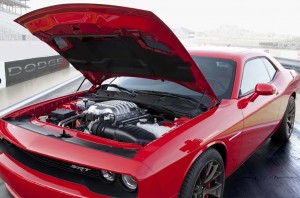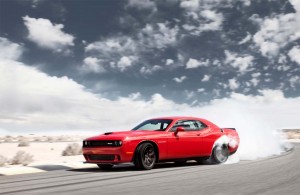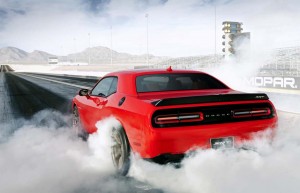When it announced plans for the new 2015 Dodge Challenger SRT Hellcat a few months ago, Chrysler’s performance brand suggested it would deliver “600-plus” horsepower. It turns out that was a big plus sign, Dodge now revealing that what it is calling “the most powerful muscle car ever” will come in at a screeching 707 hp when it hits showrooms late this year.
All the numbers have taken a big jump. SRT Powertrain Director Chris Cowland originally suggested we’d be looking at torque in the range of 575 pound-feet. It turns out that will actually be 650 lb-ft.
But we anticipate that we can still take Cowland at his word, the engineering chief earlier suggesting that the 2015 Hellcat will be “bloody fast.”
All that power will be directed to the back wheels through a new eight-speed automatic gearbox. Fans of manual transmissions will have to settle for the less powerful 2015 Dodge Challenger R/T or Hemi Challenger Scat Pack models.
The introduction of the Challenger SRT Hellcat marks the first use of V-8 supercharger technology for Dodge and SRT, the muscle coupe drawing all that power out of the new 6.2-liter Hemi Hellcat engine.
Among the more interesting features of the new model, buyers will get two different key fobs. The red one will, notes a Dodge news release, “unlock the full 707 horsepower and torque potential of the Challenger SRT Hellcat engine; while the black key fob limits the driver to a reduced engine output of 500 horsepower.”
(Click Here for details about GM reuniting a retiree with his stolen ’79 Corvette.)
A full 91% of the engine’s content has been revised, according to Cowland, including new pistons, conrods, and crankshaft. More precisely, the pistons are forged, high-strength alloy, and the piston pins use diamond-like carbon coating.
But the critical piece is the screw-type blower from IHI. Asked why Dodge engineers opted for a supercharger instead of a turbocharger, Cowland explained this approach is, “a better match to the whole vehicle characteristics we were targeting, specifically instant throttle response and low-speed torque” than what a turbo could yield.

2015 Dodge Challenger SRT Hellcat has an active exhaust, the first fully active system ever used on a Chrysler product.
One of the more interesting features added to the 2015 Dodge Challenger SRT Hellcat is the active exhaust, the first fully active system ever used on a Chrysler product.
(Trucks lose momentum in June, while plug-ins charge ahead. For more, Click Here.)
The Hellcat also gets a new, selectable Driver Mode system, explained Russ Ruedisuelli, head of SRT and Motorsports engineering, which “allows a choice of shock settings, steering assist levels, horsepower, traction setting, auto transmission calibration and shift points. There are over 125 different settings.”
The new figures reveal that the Dodge Challenger SRT Hellcat will blow right by the new Corvette Z06, which is rated at a mere 650 hp. But both vehicles make 650 lb-ft of torque. The race is likely to be closer than that might first appear, as the ‘Vette will be significantly lighter than the Dodge.
(To see more about a California district attorney filing suit against GM, Click Here.)
Meanwhile, that other mean machine from Dodge, the Viper, puts out just 640 hp and 600 lb-ft. Might the snake get its own version of the new Hellcat engine? Apparently not as, “It would require a ton of engineering,” Dan Reid, SRT’s director of product design and motorsports, told Autoblog.
Production of the 2015 Dodge Challenger SRT Hellcat begins during the third quarter, which should see the first of these beasts reach showrooms before it gets too cold to burn rubber on Detroit’s Woodward Avenue and other northern climes. Pricing will follow in the coming weeks, Dodge said.



Wow, talk about muscle! I do not know if I like the new or old Challenger better, they are both very cool.
Dodge definitely one-upped the competition with the Hellcat. It should be one helleva cool drag car. Dodge needs to find a means to lower the weight and improve the handling for the next generation Challenger.
2014 mustang super snake has 850 hp from the factory… to me it seems that is a touch more than 707 hp.
I believe the Snake is a Shelby mod v a Ford, off-the-line vehicle, hence the claim. Same as not counting a Callaway ‘Vette, for example.
Paul E.
Well, actually, no, it isn’t from the factory. Super Snakes go to Shelby for their upgrades.
the challenger hellcat will come from the factory with 707 hp at around 55k. the super snake is a 40k upgrade you have to purchase separately . in addition to the original price of the car making it 100k.
Brian the 2014 Super Snake Mustang and the 2012 V10 Mopar Challenger Super Stock car could NOT be had by anyone. There were some constraints for obtaining both vehicals beyond big $$$. As for the Hellcat, you or I can go down to Dodge and plop $5K down to order one. You are comparing apples and oranges.
“The new figures reveal that the Dodge Challenger SRT Hellcat will blow right by the new Corvette Z06, which is rated at a mere 650 hp. But both vehicles make 650 lb-ft of torque. The race is likely to be closer than that might first appear, as the ‘Vette will be significantly lighter than the Dodge.”
Uh, no. The Vette is like 400 lbs lighter and puts down power much better.
Our point exactly, JD.
Paul E.
The Super Snake is a Shelby American product. If you want to play that game then go to the 1120 hp
Hennessy Viper Venom 1000 Twin Turbo.
Uhh…Dodge never said anything about production type. Just that it’s, “the most powerful muscle car ever.” Hence, I agree that the Super Snake makes more power!
It IS a factory model v an outside mod or tuner product so, from that normally accepted standard, the Hellcat is the most powerful muscle car ever “made” (v converted).
Paul E>